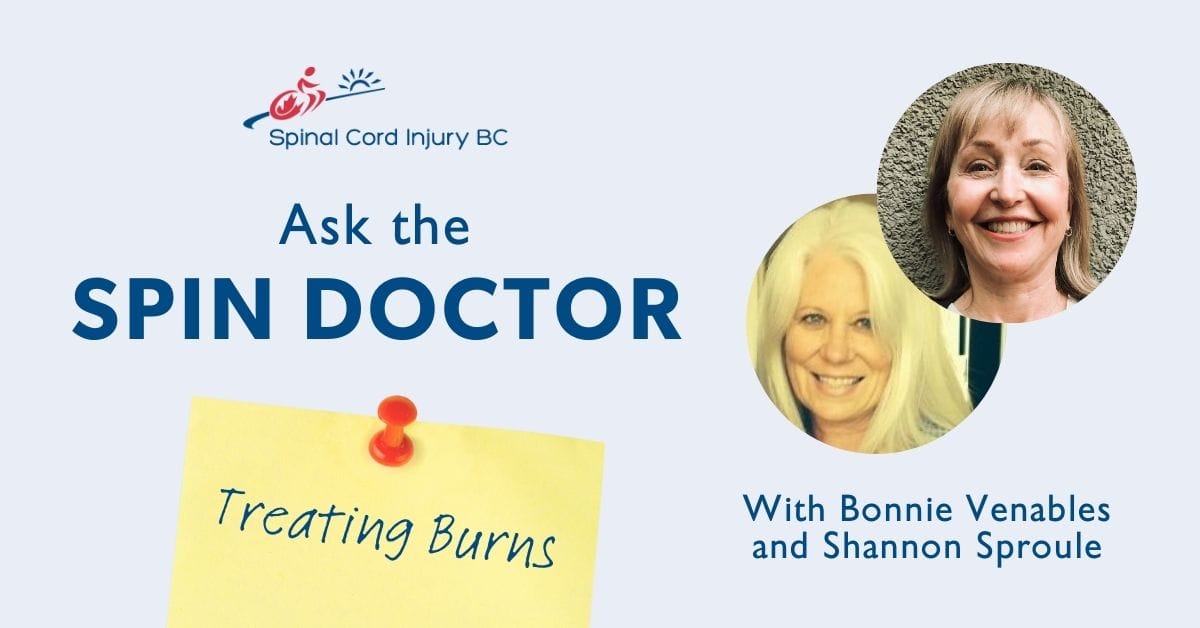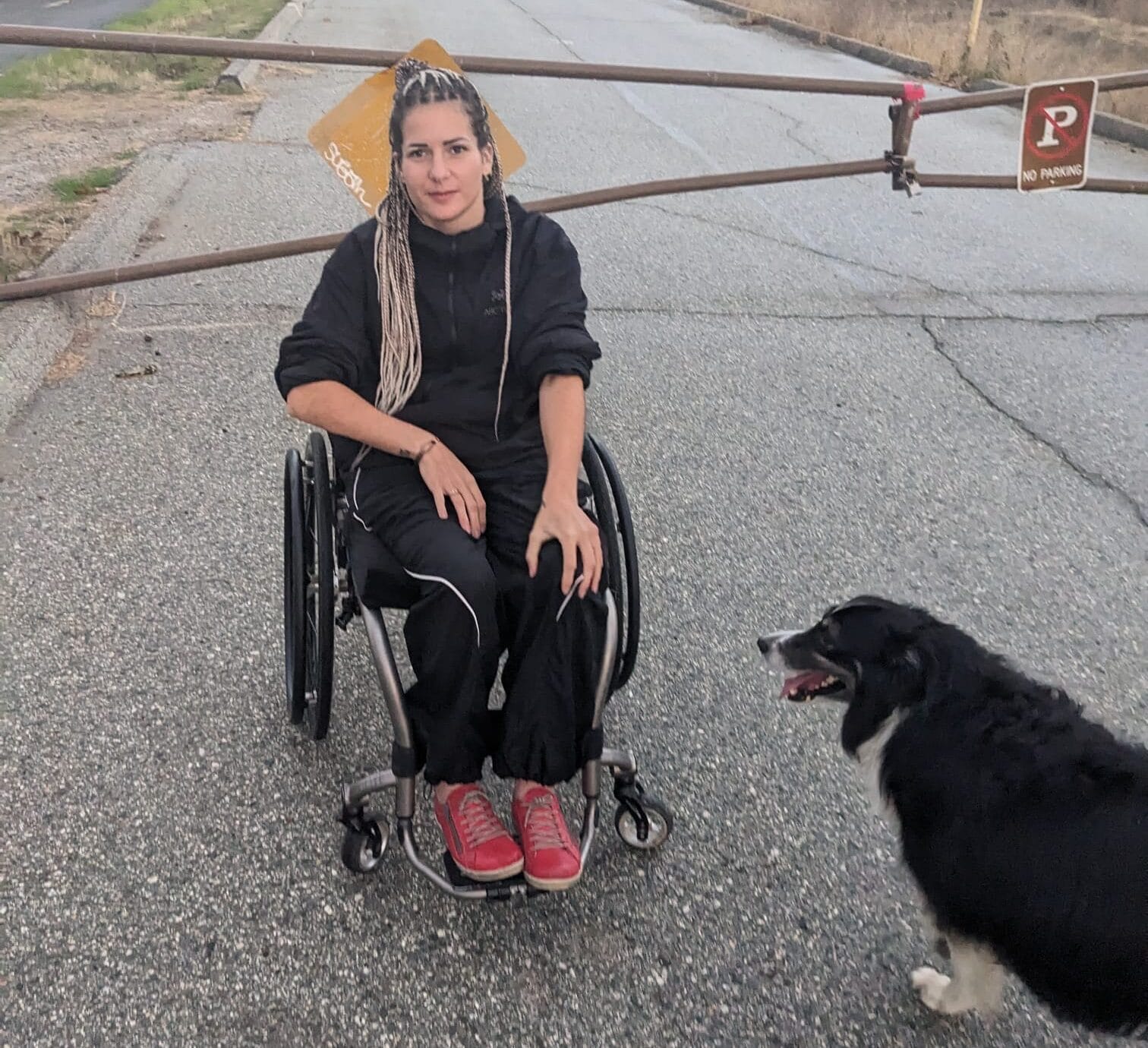
Normally, we base our Spin Doctor column on health questions posed by our readers. But for this issue, we were approached with a “burning” issue by two GF Strong clinicians. Over the years, Bonnie Venables, Clinical Resource Nurse and Shannon Sproule, Physical Therapist, have both seen their share of burns sustained by SCI BC Peers, and offer some important advice about treating and avoiding them.
In the course of our work at GF Strong, we get a surprising number of clients dropping in or calling the outpatient department seeking guidance and care for burns—burns from electric space heaters, car floor heaters, seat heaters, hot water in bathtubs or spas, kitchen accidents, heating pads and blankets, cigarettes, hot beverages, sunburns, and more. Invariably, these requests become more frequent during the colder months of the year. In the absence of lower body sensation, avoiding these burns means knowing the threats and keeping them top of mind—not always easy, we concede.
Beyond the sheer inconvenience of a burn, there are many potential complications. There’s always the risk of infection. There’s the risk of AD if your injury is T6 and above, and spasticity may increase. There’s the possibility of having your daily life activities and mobility compromised, depending on the location of the burn. Your costs for treatment (dressing care) and caregiver support may increase.
Meanwhile, healing time can take weeks depending on the depth of the burn. And healed scar tissue is never as strong or elastic as it was prior to a burn, so it sometimes limits movement (for example, in a joint area) and is subject to further breakdown.
The severity of burns is measured in degrees (first, second and third degree). Here’s an overview of the signs, symptoms and treatments.
First degree burns are the least serious. They involve only the first or top layer of your skin. Your skin will be red and appear sunburned, and it will often peel. Treatment consists of cooling the burn with cool water or a cool compress (not ice) for 10 to 15 minutes, which will decrease the temperature of the skin and prevent the burn from becoming worse (remember, tissue continues to burn even after the heat source is gone). Aloe vera can then be applied to soothe the burn.
Second degree burns, which penetrate the top two layers of your skin, are a little more serious. These burns appear red and often blister, and may also be deeper in areas where you see white patches. The first treatment step is to cool and cover the burn with a cool compress, making sure you leave any blisters intact. If there are open areas, apply an antibiotic ointment such as Polysporin. If the burn is on a limb, elevate it if possible to help reduce swelling and improve circulation. If you’re changing a dressing on a burn like this, and it gets stuck, wet the dressing with water until it loosens, and then apply a clean dressing (non-stick dressings are best). Finally, seek medical attention and direction for deeper second degree burns that may need prescription medications or special dressings.
Third degree burns are most serious, as they penetrate all skin layers. Signs are a waxy and white colour, noticeable charring or dark brown colour, a raised and leathery texture, and blisters that do not develop. Your first and only option for this type of burn: seek medical attention immediately.
If you’re in doubt about the severity of a burn, don’t hesitate to seek medical attention.
You should also seek immediate medical attention if any burn appears to be infected. Signs and symptoms of infections are increased pain or AD symptoms, warmth, redness, red streaks leading from the area, pus draining or a foul-smelling drainage, and fever.
Proper healing of any degree of burn requires that you stay hydrated and eat well.
Here’s what you can do to prevent burns:
- Test water temperature. Remember that, as a general rule, skin without sensation burns easier than sensate skin.
- Use caution when cooking. Use hot pads or trays to carry hot dishes or cookware from the stove or microwave to the table. And remember to use short sleeves when cooking on the stove—you don’t need clothing catching on fire.
- Avoid using heating pads, or electric blankets, with insensate skin.
- Use caution with spa treatments like hot massage oils, hot rocks for massage, foot baths, and hot tubs.
- Use lids on hot beverage containers such as a travel mug.
- Avoid smoking, especially in bed.
- Don’t place plates or cups on or between your legs.
- Do not have insensate body areas close to fire pits or space heaters, or even your car heater ducts, for long periods. Check skin frequently if you are.
A final reminder: once again, if you’re in doubt about a burn, don’t hesitate to seek medical attention
This article was originally published in the Fall 2017 issue of The Spin. Read more stories from this issue, including:
- Musicians
- Power Assists
- Dynamic Wheelchair Seating
And more!





